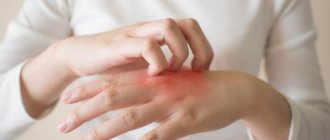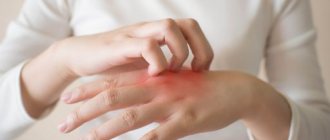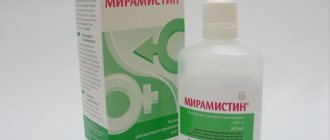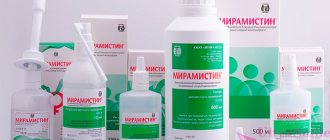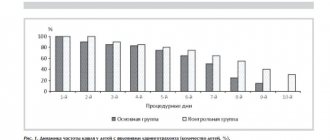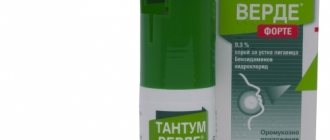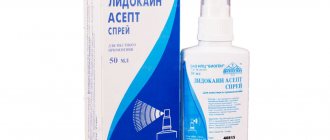Dear friends, hello!
Today, at your request, we will compare two antiseptics: Chlorhexidine and Miramistin.
We will read the instructions of both remedies and find out what their differences are, when it is better to offer Chlorhexidine, and when Miramistin.
I'll also jot down a list of customer requests for which you can offer them.
Go!
Release form
The medicine is available in the form of a solution that is applied topically. It is a clear, colorless liquid that foams when shaken.
Miramistin solution is contained in polyethylene bottles of 50 ml, 100 ml, 150 ml or 200 ml, which are placed in cardboard boxes. The kit also includes a spray nozzle or spray pump.
The release form for use in a hospital setting is 500 ml bottles.
Miramistin suppositories and tablets are not available.
Grand total
The main advantages of Chlorhexidine over Miramistin:
- Low price.
- The presence of solutions of different concentrations, which allows you to choose the optimal one for each specific situation.
- Wider range of application as a PREVENTIVE agent.
Minuses
- Lots of side effects.
- Children, pregnant women and nursing mothers - with caution.
- Bitter taste.
- Most release forms do not have a nozzle - it is inconvenient to use.
The main advantages of Miramistin over Chlorhexidine:
- Wider spectrum of action.
- More indications as a MEDICAL agent.
- Suitable for children from birth, pregnant women and nursing mothers.
- Neutral in taste.
- Few side effects.
- As a rule, a convenient nozzle is included.
Minuses:
- High price.
- Does not meet the requirements of evidence-based medicine.
pharmachologic effect
The abstract indicates that Miramistin has an antimicrobial effect, including on hospital strains that are resistant to antibiotics .
The product provides a bactericidal effect against some gram-positive and gram-negative bacteria, both aerobic and anaerobic. It also acts on hospital strains that are multiresistant to antibiotics.
The antiseptic also provides an antifungal effect, influencing ascomycetes, which belong to the genus Aspergillus and Penicillium , it also affects yeast and yeast-like fungi, dermatophytes, and a number of other pathogenic fungi, including fungal microflora, which is resistant to chemotherapy means.
Wikipedia testifies that Miramistin has an antiviral effect, showing activity against complex viruses, namely the human immunodeficiency virus, herpes , etc.
The product is also active against pathogens that are sexually transmitted to humans.
The use of Miramistin helps prevent the process of infection of burns and wounds, accelerates the process of tissue restoration, stimulates the manifestation of protective reactions when applied topically, activating the absorption and digestive function of phagocytes. The drug increases the activity of the monocyte-macrophage system. There is also pronounced hyperosmolar activity, due to which wound and perifocal inflammatory processes are effectively stopped. When treated with Miramistin, rapid adsorption of purulent exudate occurs, which contributes to the active formation of a dry scab. In this case, granulation and viable cells of the skin are not damaged, and marginal epithelialization is not inhibited.
Does not have any allergenic or local irritant effect.
Active ingredients
Sometimes I hear that they are one and the same.
It’s not just pharmacy employees who visit the blog, so I tell everyone:
No, they have different active ingredients.
In Chlorhexidine, the active substance is called "chlorhexidine bigluconate".
Already from the name it is clear that the composition contains chlorine.
Let us remember bleach and chloramine, which have long been used for disinfection, since they mercilessly deal with microbial cells.
Chlorhexidine is from the same opera. I mean, it's just as strong an antiseptic.
It was synthesized in Great Britain in 1950, and then, having demonstrated its antimicrobial properties in clinical studies, it spread to different countries and continents.
Miramistin. The active ingredient sounds quite simple: benzyldimethyl (3-(myristoylamino) propyl) ammonium chloride monohydrate.
Its history dates back to the 70s of the last century in the USSR.
It was originally conceived for astronauts. Already during the first space flights, alarming news began to arrive from orbit: in the cabins of ships, it was not apple and pear trees that bloomed lushly, but colonies of bacteria and fungi.
This was predisposed to a confined space, a constant temperature of 22-23 degrees and microorganisms that normally live on the skin and hair of astronauts. And those antiseptics with which they were supplied on their journey turned out to be powerless.
Therefore, it was necessary to develop a drug that would act on bacteria, including antibiotic-resistant viruses, and fungi.
Preclinical trials took 10 long years.
And then hard times came for the country. Funding for many promising projects has ceased.
The new antiseptic might never have been published if it had not been for the Olympics in Moscow. It was expected that thousands of foreigners would come to the capital, and the USSR Ministry of Health was worried that there would be a surge in sexually transmitted diseases in a country where “there was no sex.”
Then the Minister of Health received information on Chlorhexidine and, just in case, on Miramistin (it was called differently in those years), which in studies showed itself to be unique in many respects.
The Minister of Health was impressed by the properties of the new antiseptic, and work on it continued.
In 1993, the first batch of the drug was released.
So if Chlorhexidine was originally a foreign creation, Miramistin is ours, ours.
Indications for use
The following indications for the use of Miramistin are determined:
- In traumatology and surgery it is used to prevent suppuration and to treat purulent wounds. Used in the treatment of purulent-inflammatory diseases of the musculoskeletal system.
- In obstetrics and gynecology, the indications for use are as follows: treatment and prevention of suppuration of wounds and injuries received during childbirth, treatment of inflammatory and infectious processes of the genital organs. The doctor explains in detail how to use Miramistin in gynecology when prescribing.
- In venereology and dermatology, it is prescribed for the treatment and prevention of dermatomycosis, pyoderma, and is also used for candidiasis of the skin and mucous membranes, in particular, for thrush.
- In urology, Miramistin is prescribed for urethritis and urethroprostatitis. Treatment with the drug is practiced for acute and chronic urethritis.
- In dentistry, it is prescribed for the purpose of preventing the treatment of infectious and inflammatory processes occurring in the oral cavity. Treatment with Miramistin is practiced for stomatitis (possible use for stomatitis in children), gingivitis , periodontitis. The product is also used to treat removable dentures.
- In otorhinolaryngology it is used for sinusitis , otitis, laryngitis , pharyngitis, chronic tonsillitis. Miramistin is prescribed for sore throat . In particular, the drug is used in complex therapy for pharyngitis, chronic tonsillitis, as well as for sore throat in children from the age of three.
- The product is also used in the treatment of deep and superficial burns, in the process of preparing wounds resulting from burns for dermatoplasty.
- The solution is used for individual prevention of the development of diseases that are sexually transmitted to humans.
How do Chlorhexidine and Miramistin work?
Chlorhexidine:
Damages the cell membrane of the microbial cell, increases its permeability. The substances necessary for its existence leak and it dies.
- At a concentration of less than 0.01% it has a bacteriostatic effect, i.e. suppresses the growth of bacteria.
- At a concentration of more than 0.01%, it destroys microbes and complex viruses (has a bactericidal and virucidal effect).
- At a concentration above 0.05% it destroys pathogenic fungi.
Conclusion: the 0.05 and 0.5% solutions of Chlorhexidine available in pharmacies are effective against various pathogens.
BUT: Chlorhexidine may cause irritation to the skin and mucous membranes. It sometimes causes chemical burns (mainly mucous membranes).
Miramistin:
- Has a bactericidal effect. The mechanism is similar to Chlorhexidine.
- Activates regeneration (healing) processes.
- Has hyperosmolar activity. This means that it attracts inflammatory exudate, which reduces inflammation in and around the wound.
- Sorbs (absorbs) purulent exudate. A dry crust forms faster. It protects the wound from germs and dirt.
Does not damage living skin cells. Does not cause chemical burns.
Conclusion: Miramistin has a milder effect than Chlorhexidine and is safer.
Instructions for use of Miramistin (Method and dosage)
If a patient is prescribed Miramistin, the instructions for use must be carefully followed. Before using the solution contained in the package with a spray nozzle, you must remove the cap and attach the spray nozzle to the bottle. The nozzle must be activated by pressing the nebulizer again, after which the medicine can be used.
When treating wounds and burns, the solution is used to irrigate burns and wounds; the drug is also used to wet gauze swabs.
In gynecology, during the postpartum days, vaginal irrigation is practiced, which is carried out for 5-7 days. If a child is born by cesarean section , the vagina is treated with Miramistin before the operation. During the operation, the uterine cavity, as well as the incision made on it, is treated with a solution. Next, after the operation, tampons with a solution are inserted into the vagina, like suppositories, for one week. Tampons should be kept in the vagina for two hours.
If Miramistin spray is prescribed for purulent sinusitis, the instructions for use stipulate that the drug should be used to rinse the maxillary sinus during the puncture. How to rinse your nose at home should be learned from the doctor who prescribes the drug.
For tonsillitis , purulent sinusitis, pharyngitis, you should either irrigate the throat using a special nozzle, or gargle. How to gargle with Miramistin depends on the intensity of the symptoms of the disease. As a rule, 10-15 ml of product is used per rinse. The product can also be used for inhalation.
Instructions for use of Miramistin for children with tonsillitis or acute pharyngitis include irrigation. For children 3-6 years of age, irrigation is carried out with a single press; irrigation is carried out 3 or 4 times per day. Children from 7 to 14 years old are irrigated by double pressing, the frequency is 3-4 times a day. Duration of treatment is from 4 to 10 days.
Miramistin for angina is used to treat both adults and children in the form of rinses and inhalations. For sore throat in children, rinsing is done 4-5 times. Miramistin for inhalation with a nebulizer can only be used if prescribed by a specialist. The fact is that inhalation with Miramistin through a nebulizer produces a very fine spray, which can sometimes cause an allergic reaction.
Miramistin can be instilled into the nose only after a doctor’s prescription. Whether this remedy can be dripped into the nose depends on the individual characteristics of the course of the disease. When using medicine for a runny nose, it should be borne in mind that this solution can irritate the nasal mucosa. You should use the product especially carefully when you have a runny nose in children, considering what Miramistin is and what properties the solution has.
Patients with stomatitis and other dental diseases should rinse their mouth 3 to 4 times a day. How to rinse your mouth depends on the disease, but generally 10-15 ml of product is used for one rinse.
The solution is used to treat affected surfaces if it is necessary to get rid of acne.
Miramistin packaging with a urological attachment is used in urology and venereology. How to do douching, and under what conditions it is advisable to use it, should be learned from your doctor.
Miramistin spray is injected into the urethra for the treatment of urethritis and urethroprostatitis. Injection is carried out 1-2 times a day in a dose of 2-3 ml of the product for 10 days.
It should be taken into account when using Miramistin that this remedy is also used for the prevention of sexually transmitted diseases. However, it is only effective if used no later than two hours after sex. You should clearly know how to use the solution for this purpose: you need to inject the drug into the urethra for 2-3 minutes: men inject 2-3 ml of the product, women - 1-2 ml into the urethra and another 5-10 ml into the vagina. It is also necessary to treat the skin on the genitals and thighs.
Miramistin for thrush , as well as for inflammatory diseases of the female genital organs, is administered intravaginally, for which a tampon is moistened with the solution. For thrush in women, douching is also done, which should be done for seven days.
Whether Miramistin can be dripped into the ear depends on the disease and the intensity of the symptoms. If the patient is diagnosed with purulent otitis media, 2 ml of solution must be injected into the external auditory canal.
When are Chlorhexidine and Miramistin used?
Chlorhexidine:
- Prevention of sexually transmitted diseases: syphilis, gonorrhea, trichomoniasis, chlamydia, herpes, HIV, etc.
- Disinfection of hands, instruments, surgical field.
- Prevention of suppuration of abrasions and wounds.
- Festering wounds.
- Burns – to prevent infection.
- Oral diseases: gingivitis, stomatitis, periodontitis, etc.
- Prevention of infection after dental operations (for example, tooth extraction) and manipulations.
- In gynecology, Chlorhexidine irrigation is used to prevent postpartum infection.
- In urology - in the complex treatment of urethritis (inflammation of the urethra).
- Prevention of fungal infection after visiting baths, saunas, swimming pools.
- Treating shoes to prevent re-infection during the treatment of mycoses of the feet.
- Disinfection of the injection site in the absence of alcohol or alcohol wipes.
Miramistin:
The price of Miramistin is significantly higher, so, as a rule, it is NOT used to disinfect hands, instruments, shoes, or to prevent fungal infections after visiting public places where you can pick up a fungus.
The rest of the readings are the same.
Additionally:
- Complex treatment of otitis (drip into the ear, put turundas), sinusitis (during puncture, the maxillary sinuses are washed).
- If necessary, it can be dropped into the eyes: conjunctivitis, eye injury, burn. There are even eye drops containing Miramistin in the same concentration as the solution for external use. They are called Okomistin.
Conclusion:
Chlorhexidine in solution has a wider range of applications as a PREVENTIVE agent, and Miramistin - as a MEDICINE.
special instructions
No mutagenic effects of the drugs were detected during the study.
Do not allow the product to come into contact with the eyes. Miramistin for eyes is used only after prescription by a specialist. At the same time, you should definitely ask your doctor about whether it is possible to wash your eyes with this solution and how to do it correctly. For the treatment of eye diseases, the drug Okomistin based on miramistin .
Since this remedy has a wide range of effects, it is prescribed for mixed fungal and bacterial infections. As a rule, this occurs at the first stage of therapy, before a diagnosis is made.
Side effects of Chlorhexidine and Miramistin
Chlorhexidine
- Allergic reaction.
- Dry skin.
- Skin itching.
- Dermatitis.
- Photosensitivity, i.e. the appearance of a rash on the skin after exposure to the sun.
- The appearance of brown spots on the teeth after frequent rinsing of the mouth.
- Tartar deposits.
- Taste disturbance.
Important: In February 2022, the FDA issued a notice warning that cases of anaphylactic shock have been reported with the use of Chlorhexidine-based products. Therefore, when selling Chlorhexidine, find out whether the buyer is prone to allergies.
Miramistin
- A slight burning sensation (passes in a few seconds).
- Allergic reaction.
Conclusion: Miramistin produces fewer adverse reactions and is better tolerated.
Analogues of Miramistin
Level 4 ATC code matches:
Drapolene
Miramistin Darnitsa
Dekasan
Analogues of Miramistin in Russia are the drugs Chlorhexidine , Decasan , Octenisept , etc. The price of analogues can be higher or lower. However, only a specialist can finally determine what can replace Miramistin in each specific case.
Which is better: Miramistin or Chlorhexidine?
Often, when looking for a drug that can replace Miramistin, this drug is compared with the drug Chlorhexidine. Answering the question of what is the difference between Chlorhexidine and Miramistin, experts note that Chlorhexidine is more toxic and also provokes the development of more pronounced side effects. These drugs have different compositions, although the indications for use are almost the same. But doctors consider Miramistin a safer and gentler remedy, which is why it can be prescribed for the treatment of children. At the same time, Chlorhexidine has more pronounced antimicrobial activity.
For children
Miramistin for children is prescribed for acute pharyngitis, as well as for exacerbation of chronic tonsillitis. The instructions for Miramistin spray for children stipulate that the product is prescribed to children under 3 years of age only according to indications. Children under one year of age should be treated with the solution under the supervision of a specialist.
You should be careful when dripping Miramistin into the nose of a child with a runny nose, as irritation of the mucous membrane is possible. Inhalations using this drug are rarely prescribed to children. For chickenpox in children, the affected skin surface can be treated with a solution. For conjunctivitis in children, it is advisable to use other drugs, since Miramistin can provoke the development of allergic reactions.
Miramistin for infants is used for irrigation using a spray nozzle. For infants, the product can also be used to treat surfaces that require disinfection.
Miramistin during pregnancy and lactation
Miramistin can be used during pregnancy , as well as during breastfeeding, if there are appropriate indications. If you gargle during pregnancy, or drop Miramistin into your nose during pregnancy, the likelihood of absorption of the active substance into the bloodstream is unlikely. Therefore, Miramistin can be used for the throat, as well as for disinfecting affected surfaces during pregnancy. You should ask your doctor in detail how to use the medicine. During pregnancy, during treatment with this drug, it is necessary to periodically observe a specialist.
Systemic effects
Chlorhexidine
When applied topically the aqueous solution is not absorbed into the bloodstream and does not have a systemic effect. In case of accidental entry into the stomach, it is not absorbed.
BUT: nevertheless, the manufacturer warns:
In case of accidental ingestion of the solution, perform a gastric lavage and give a sorbent.
Apparently, this is why in the instructions for Chlorhexidine we do NOT see a clear recommendation to use it for sore throat and tonsillitis. Not everyone knows how to gargle correctly. This is especially true for children. They can easily swallow it.
The alcohol solution is partially absorbed through the skin and can cause depression of the central nervous system.
Special instructions:
If any Chlorhexidine solution accidentally gets into your eyes, rinse them quickly and thoroughly with water.
Avoid contact with the inner ear. This could be the case, for example, with perforated otitis media. Therefore, Chlorhexidine is not dripped into the ear.
Miramistin
When applied topically, it is not absorbed through the skin and mucous membranes.
Accidental ingestion does not pose a health hazard. The drug will come out naturally.
Conclusion:
Miramistin is safer.
Reviews about Miramistin
There are often positive reviews of Miramistin on the Internet. Patients note that this drug is indeed a very effective antiseptic. Women write about its use in gynecology, which made it possible to quickly cure infectious diseases of the genital organs.
Reviews of Miramistin for children indicate that the solution speeds up the healing process of wounds, it is effective for sore throat and other diseases. Reviews of the spray for children contain virtually no information about side effects. In rare cases, parents write about the manifestation of a short-term burning sensation. Many users also write that the solution helped them quickly get rid of acne and speed up the healing of burns.
Given the fact that the medicine is a universal antiseptic, Miramistin is often used for the throat. Using it to rinse with a sore throat, users note that after a few days there is a pronounced relief of the condition. A good effect also appears after spraying the solution into a child’s throat and even into an infant’s throat. Often, gargling provides some relief after the first use. Sometimes patients ask if they can swallow the solution, to which doctors warn them against such actions.
Customer requests when it is possible to offer an antiseptic solution
- I need some antiseptic for the road.
- Irritation after epilation.
- Skin irritation after shaving.
- Wet (water) callus. (Treat the needle and skin with an antiseptic, carefully pierce the callus, treat the skin again with an antiseptic).
- How to disinfect the ear after a piercing?
- How to disinfect the skin after piercing/tattoo?
- How can you treat a trophic ulcer? (Offer an antiseptic in combination with other products).
- How to treat bedsores? (Offer an antiseptic in combination with other products).
- How to treat shoes with fungus so as not to become infected again?
- I need something for foot fungus. (Suggest antifungal plus Chlorhexidine for shoe treatment and healthy foot skin).
- I go to the pool/sauna. Is there anything to protect yourself from fungus?
- Mouth ulcers. (Offer an antiseptic in combination with other agents. If a child has , Miramistin is preferred).
- The gums are inflamed. (Offer an antiseptic in combination with other products).
- White plaque in my mouth, I took an antibiotic. a child has oral candidiasis, use Miramistin. Do not spray small children in the mouth! Wrap a bandage around your finger, wet it with Miramistin and treat the mouth).
- The tooth was removed. How can you rinse your mouth? The doctor didn't prescribe anything.
- I need alcohol for injections. – (Suggest 0.5% alcohol solution of Chlorhexidine).
- I have a sore throat. I need something to gargle. Only cheaper. (Chlorhexidine).
What else? Add!
Miramistin price, where to buy
You can buy Miramistin (solution) at any pharmacy without a doctor's prescription. How much this product costs at the pharmacy depends on the volume of the package. The price of Miramistin in pharmacies averages 200-300 rubles per 50 ml. The price of Miramistin spray for children 150 ml is on average 370 rubles. A 500 ml bottle costs about 800-1000 rubles. How much a medicine costs in a pharmacy in Krasnoyarsk and in other cities of Russia should be found out at specific places where medicines are sold.
The price of Miramistin in Ukraine (Kharkov, Odessa, other cities) ranges from 60 to 80 UAH. per bottle 50 ml. The cost of the product in Belarus is on average 50,000 rubles. per bottle 50 ml.
- Online pharmacies in RussiaRussia
- Online pharmacies in UkraineUkraine
LuxPharma* special offer
- Miramistin ointment 5 mg/g tube 30 g
RUB 1,380 order
ZdravCity
- Miramistin solution of places. approx. 0.01% 150mlInfamed K
426 rub. order
- Miramistin solution of places. approx. 500mlInfamed K
903 rub. order
- Antimicrobial sterile plaster with miramistin Dokaplast 8cm x 15cm 25 pcs. LLC New Dressing materials
427 RUR order
- Antimicrobial sterile plaster with miramistin Dokaplast 1.9 cm x 7.2 cm 10 pcs. LLC New Dressing materials
43 RUR order
- Antimicrobial sterile plaster with miramistin Dokaplast 10cm x 20cm 5 pcs. LLC New Dressing materials
190 rub. order
Pharmacy Dialogue
- Miramistin bottle 0.01% 150ml with spray Infamed
427 RUR order
- Miramistin (vial 0.01% 50ml + urological attachment) Infamed
RUB 237 order
- Miramistin (vial 0.01% 500ml)Infamed
RUR 891 order
- Miramistin (vial 0.01% 50ml + urological nozzle + spray) Infamed
RUB 259 order
- Miramistin bottle 0.01% 500mlInfamed
RUR 879 order
show more
Pharmacy24
- Miramistin-Darnitsa 5 mg/g 30 g ointment PrAT" Pharmaceutical company "Darnitsa", Ukraine
65 UAH. order - Miramistin-Darnitsa 0.5% 15 g ointment PrAT" Pharmaceutical company "Darnitsa", Ukraine
32 UAH order
- Miramistin 50 ml solution PrAT" Pharmaceutical company "Darnitsa", Ukraine
80 UAH order
- Methyluracil with miramistin 30 g ointment PrAT” Pharmaceutical company “Darnitsa”, Ukraine
68 UAH order

